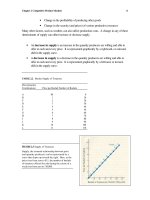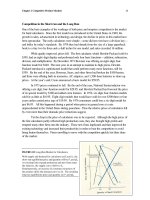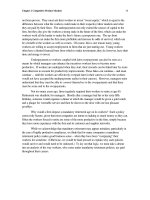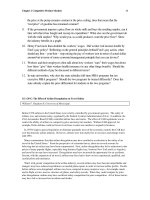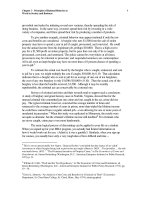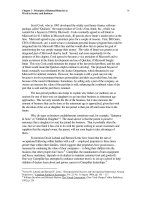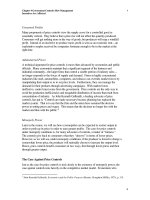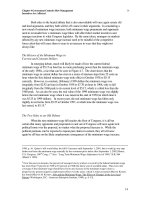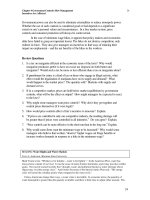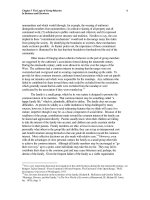Tài liệu Microeconomics for MBAs 24 pptx
Bạn đang xem bản rút gọn của tài liệu. Xem và tải ngay bản đầy đủ của tài liệu tại đây (208.93 KB, 10 trang )
Chapter 6. Reasons for Firm Incentives
49
the cost will be borne by the employers. Nothing is free in business, especially education. No
matter what the form, someone will pay the piper.
Concluding Comments
Our message in this chapter and repeated elsewhere in this textbook, repeated and reinforced
with analysis and anecdotes is simple: Incentives are important. They are worthy of serious
reflection. But that doesn’t mean to suggest that incentives are all that matter. Surely, many
things matter. As noted earlier, leadership, product design, and customer service, as well as
company adaptability, culture, and goals, also matter. However, we suspect that all of those
good things in business might not matter very much or for long if the incentives are not right. In
their effort to get incentives right, it is altogether understandable why some firms will cover the
cost of the MBA degree program for some of their workers (and not others). In general, firms
can be expected to cover the cost of an MBA when they, the firms, can expect to capture the
benefits. On the other hand, the workers themselves can be expected to pay for their own
degree expenses when they, the workers, expect to capture the benefits.
We hope our discussion of the importance of incentives in understanding the
organization and performance of firms serves as an incentive to spend more time thinking and
reading about incentives, a subject to which we will return later in the book and course.
Review Questions
1. Why are some firms “large” and other firms “small”? Use the concepts of “coordinating
costs” in your answer
2. Suppose firms get smaller. Why might that happen?
3. If worker-monitoring costs go down, what will happen to the size of the firm?
4. What have been the various effects of the computer/telecommunication revolution on the
sizes of firms?
5. Why would a firm hire its own accountants to keep the books but, at the same time, use
outside lawyers to do its legal work?
6. If your firm fears being “held up” by an outside supplier of a critical part to your
production process, what can your firm do to reduce the chance of a hold up?
CHAPTER 7
Market Failures: External
Costs and Benefits
In its broadest definitional sense, collective action is the enactment and enforcement of
law. The justification for all collective action, for government, lies in its ability to make
men better off. This is where any discussion of the bases for collective action must begin.
James Buchanan
ow much should government involve itself in the marketplace? How much does
business want government involvement.” These questions touch on one of the
most important economic issues of our time: the division of responsibility
between the public and private sectors. In general, economic principles would suggest
that government undertake only functions that it can perform more efficiently than the
market. As we will see, businesses are not always opposed to government involvement
in the economy. Indeed, many businesses have incentives to try to make sure that
government is more involved in the economy than is “efficient.”
Economics provides a method for evaluating the relative efficiency of government
and the marketplace. It enables the United States to identify which goods and services
the market will fail to produce altogether, and which it will produce inefficiently. We
saw in an earlier chapter that such market failures have three sources: monopoly power,
external costs, and external benefits. Now, using the principles and graphic analyses
developed in earlier chapters, we will take a closer look at external costs and benefits and
at government attempts to capture them and correct market failures. (See later chapters
on monopoly and monopsony power.)
External Costs and Benefits, Again
In a competitive market, producers must minimize their production costs in order to
lower their prices, increase their production levels, and improve the quality of their
products. Consumers must demonstrate how much they will pay for a product, and in
what amount they will buy it. In a competitive market, production will move toward the
intersection of the market supply and demand curves -- Q
1
in Figure 7.1. At that point
the marginal cost of the last unit produced will equal its marginal benefit to consumers.
To the extent that the market moves toward equilibrium in supply and demand, it is
efficient in a very special sense. As long as the marginal benefit of anything people do is
greater than the marginal cost, people are presumed to be better off if quantity increases.
In Figure 7.1, for each loaf of bread up to Q
1
, the marginal benefit of consumption (as
H
Chapter 7 Market Failures: External Costs
And Benefits
2
shown by the demand curve) exceeds the marginal cost of production (as shown by the
supply curve). Because the marginal cost of a loaf of bread is the value of the most
attractive alternative forgone, people must be getting more value out of each of those
loaves than they could from any alternative good. By producing exactly Q
1
loaves—no
more and no less—the market extracts the possible surplus or excess benefits from
production (see shaded area on the graph) and divides them among buyers and sellers. In
this sense, production and distribution of economic resources can be said to be efficient.
__________________________________________
Figure 7.1 Marginal Benefit versus Marginal Cost
The demand curve reflects the marginal benefits of
each loaf of bread produced. The supply curve
reflects the marginal cost of producing each loaf.
For each loaf of bread up to Q
1
, the marginal
benefits exceed the marginal cost. The shaded area
shows the maximum welfare that can be gained
from the production of bread. When the market is at
equilibrium (when supply equals demand), all those
benefits will be realized.
These results cannot be achieved unless competition is intense, buyers receive all
the product’s benefits, and producers pay all the costs of production. If such optimum
conditions are not achieved, the market fails. Part of the excess benefits shown by the
shaded area in the figure will not be realized by either buyers or sellers.
When exchanges between buyers and sellers affect people who are not directly
involved in the trades, they are said to have external effects, or to generate externalities.
Externalities are the positive or negative effects that exchanges may have on people who
are not in the market. They are third-party effects. When such effects are pleasurable
they are called external benefits. When they are unpleasant, or impose a cost on people
other than the buyers or sellers, they are called external costs. The effects of external
costs and benefits on production and market efficiency can be seen with the aid of supply
and demand curves.
External Costs
Figure 7.2 represents the market for a paper product. The market demand curve, D,
indicates the benefits consumers receive from the product. To make paper, the producers
must pay the costs of labor, chemicals, and pulpwood. The industry supply curve, S
1
,
shows the cost on which paper manufacturers must base their production decisions. In a
Chapter 7 Market Failures: External Costs
And Benefits
3
perfectly competitive market, the quantity of the paper product that is bought will be Q
2
,
and the price paid by consumers will be P
1
.
____________________________________
FIGURE 7.2 External Costs
Ignoring the external costs associated with the
manufacture of paper products, firms will base their
production and pricing decisions on supply curve S
1
.
If they consider external costs, such as the cost of
pollution, they would operate on the basis of supply
curve S
2
, producing Q
1
instead of Q
2
units. The
shaded area shows the amount by which the marginal
cost of production of Q
2
-- Q
1
units exceeds the
marginal benefits to consumers. It indicates the
inefficiency of the private market when external costs
are not borne by producers.
___________________________________________
Producers may not bear all the costs associated with production, however. A by-
product of the production process may be solid or gaseous waste dumped into rivers or
emitted into the atmosphere. The stench of production may pervade the surrounding
community. Towns located downstream may have to clean up the water. People may
have to paint their houses more frequently or seek medical attention for eye irritation.
Homeowners may have to accept lower prices than usual for their property. All these
costs are imposed on people not directly involved in the production, consumption, or
exchange of the paper product. Nonetheless, these external costs are part of the total cost
of production to society.
In a perfectly competitive market, in which all participants act independently,
survival may require that a producer impose external costs on others. An individual
producer who voluntarily installs equipment to clean up pollution will incur costs higher
than those of its competitors. It will not be able to match price cuts, and so in the long
run may be out of business -- and some producers may not care whether they cause harm
to others by polluting the environment. Even socially concerned producers cannot afford
to care too much about the environment.
The supply curve S
2
incorporates both the external production costs of pollution and
the private costs borne by producers. If producers have to bear all those costs, the price
of the product will be higher (P
2
rather than P
1
), and consumers will buy a small quantity
(Q
1
rather than Q
2
). Thus the true marginal cost of each unit of paper between Q
1
and Q
2
is greater than the marginal benefit to consumers. If consumers have to pay for external
costs, they will value other goods more highly than those units. In a sense, then, the
paper manufacturers are overproducing, by Q
2
-- Q
1
units. The marginal cost of those
units exceeds their marginal benefit by the shaded triangular area.
Chapter 7 Market Failures: External Costs
And Benefits
4
Other examples of external costs that encourage overproduction are the highway
congestion created by automobiles and the noise created by airplanes in and around
airports. The argument can also be extended to include less obvious costs, like the death
and destruction caused by speeding and reckless driving. If government does not
penalize such negligent behaviors, people will produce them, at a potentially high
external costs to others. In the same way, adult bookstores, X-rated movie houses, and
massage parlors impose costs on neighboring businesses. Their sordid appearance drives
away many people who might otherwise patronize legitimate businesses in the area.
External Benefits
Sometimes market inefficiencies are created by external benefits. Market demand does
not always reflect all the benefits received from a good. Instead, people not directly
involved in the production, consumption, or exchange of the good receive some of its
benefits.
To see the effects of external benefits on the allocation of resources, consider the
market for flu shots. The cost of producing vaccine includes labor, research and
production equipment, materials, and transportation. Assuming that all those costs are
borne by the producers, the market supply curve will be S in Figure 7.3.
__________________________________________
Figure 7.3 External Benefits
Ignoring the external benefits of getting flu shots,
consumers will base their purchases on demand
curve D
1
instead of D2. Fewer shots will be
purchased than could be justified economically -- Q
1
instead of Q
2
. Because the marginal benefit of each
shot between Q
1
and Q
2
(as shown by demand curve
D
2
) exceeds it marginal cost of production, external
benefits are not being realized. The shaded area abc
indicates market inefficiency.
___________________________________
Individuals receive important personal benefits from flu shots. The fact that many
millions of people pay for them every year shows that there is a demand, illustrated by
curve D
1
in Figure 7.3.
In getting shots for themselves, however, people also provide
external benefits for others. By protecting themselves, they reduce the probability that
the flu will spread to others. When others escape the medical expenses and lost work
